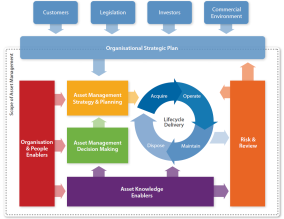ENG8104 | Asset Management in an Engineering Environment | Management
Background
You are an asset manager for a medium sized company, the primary purpose of which is to provide services or products to industrial and/or domestic consumers. Some examples of such an organisation include, but are not limited to:
- Water supply authority
- Sewerage authority
- Road network owner
- Electricity supply company
- Gas supply company
- Telecommunications provider
- Systems network provider
- Power station owner
- Product manufacturer.
Your organisation owns a network of assets that enable it to deliver its services. The assets in the network are of various types, sizes, ages and condition. Because of financial constraints over the past several years, the assets in the network have not been replaced except when absolutely necessary. Maintenance equipment is also not in a generally good condition. Inspection is mainly by visual means, supplemented where required by more detailed investigation.
While a basic asset management system program is in place, few minor assets are recorded on it. Most assets are still located by traditional methods such as links of key reference points (for example, bends, pits, poles, equipment) to property boundaries and centreline distances, building locations, similar types of reference points, or in some cases no reference points. Other asset information is minimal, and is mainly limited to information that is absolutely necessary for maintenance purposes.
There is concern that your organisation’s assets are not always located as per your organisation’s records. The situation has been exacerbated by poor record keeping in the past, and by not recording changes when there have been changes to key asset data, including location.
This poor state of records makes it difficult for other service providers to have sufficient confidence in the information you supply about your assets for their design, construction and maintenance.
Over the past several years, there have been a steadily increasing number of complaints by users of your assets as a result of numerous breakdowns in service and failures. Were it not for the fact that there are a number of barriers of entry to the business in which your organisation is engaged (for example, cost, government licences, technology), and the fact that the charges your organisation has levied for usage of its services are cheaper than similar services elsewhere, your organisation might by now be in considerable difficulty
With changes in technology and lessening government controls, there are a number of potential competitors entering the market. The rapid technological changes in the assets under your organisation’s control, in asset management processes and methods, the increasing use of advanced data collection and analysis, and in the types of products delivered by your organisation, are increasingly placing competitors in a position to challenge your organisation to perform.
In search for an answer to what are clearly a number of looming concerns, your organisation has recently appointed you to develop an asset management strategy that meets your board’s targets of best industry practice for your particular type of asset network within five years, and a national leadership position within ten years.
Funds – but not unlimited funds – have been made available for this purpose. Your organisation is expecting that the vastly improved standard of service brought by your management skills will bring contented customers who will pay the additional price required for a modern and reliable service.
New technologies are available that are expected to assist you to minimise the cost of upgrading your asset, improve data collection and analysis, select the best type of maintenance and rehabilitation, and enable your organisation to take a leading position in the asset management field. Other new technologies are likely to enable you to increase the choices available to the consumer and greatly improve the quality of service provided.
Your Task
Write a submission to your chief executive officer of your organisation describing a strategy to review and improve your organisation’s assets, their management, and the standard of service which they provide, to achieve the board’s goals.
You will need to select the organisation, type of assets and asset network you are managing.
While a real organisation is preferred, you may write your answer for a hypothetical organisation. You should indicate whether the organisation about which you are writing is real or hypothetical.
Your submission should be between 3000 and 4000 words in length and will have, in addition to the body of the report, an abstract, table of contents, background, introduction, conclusion and list of references. Background information should be as brief as possible and include a brief description of your organisation, its asset network, services provided by that asset network, and current state of the network. The report should consider likely future technological, regulatory and administrative changes with respect to asset management.
- straight line Tabulate the depreciation and book value for the life of the item by each of the following methods:
- declining balance
- sum of digits. (15 marks)
- Tabulate details of a sinking fund to accumulate to the original purchase price less residual value assuming an interest rate of 6% per annum. (10 marks)
- Draw a graph showing the book values in each of the above (plotted on the same graph for comparison). (10 marks)
- Discuss, using examples, under what circumstances each depreciation method would be used to arrive at a fair value of the asset at any particular stage of its life. (10 marks)
- Assume the cost of money is 9% per annum. Calculate the annual cost of purchasing this asset. State any assumptions. (5 marks)
- Assume that this asset works for 1,400 hours per year. Explain, giving an example calculation, how you evaluate the hourly cost of using this asset. How would this impact on any charges the asset owner might levy for its use? (5 marks)
- Suppose at the end of the asset’s life a cheaper alternative was available. This cheaper alternative has a similar life and standard of service to the existing asset. Discuss any implications for valuation of the existing asset. (10 marks)
Question 3 (120 marks)
Asset Management Economics
- Using at least two (2) references to support your answer, discuss in 400 to 600 words the issues that you might consider in assessing and comparing alternative options for purchasing, rehabilitating, or replacing assets. (30 marks)
- An asset under your management, with an estimated design life of 15 years, cost
$3,100,000 to purchase and install. It currently has a revenue stream of $870,000 per year.
Costs of operation and maintenance of this asset are as follows:
- $340,000 for Years 1 and 2 of the life of the asset
- $380,000 per year for Years 3 to 12 of the life of the asset
- $480,000 per year for years 13 and 14 of the life of the asset
- $600,000 per year for year 15 of the life of the asset.
At the moment, this asset is 14 years old, and therefore a decision needs to be made with respect to the best option for continuing use of it. Condition monitoring information confirms that the asset is nearing the end of its design life and should be replaced once that life is reached.
The replacement process will take about six months and commence at the end of the design life of the old asset, which will remain in service until its replacement is installed. Because of some loss of service of the asset during the replacement period, there will be a loss of revenue of $300,000 in the year of replacement.
The residual value of the replaced asset is $550,000. It will cost $280,000 to remove the asset from service when it is replaced.
The asset can be rehabilitated at the end of 15 years of service at a cost of $2,200,000. It then be expected to last a further 15 years.
Costs of operation and maintenance of the rehabilitated asset are expected to be as follows:
- $430,000 per year for Years 1 to 8 of the life of the rehabilitated asset
- $950,000, which includes major refurbishment work, in Year 9 of the life of the rehabilitated asset
- $490,000 per year for Years 10 to 15 of the life of the rehabilitated asset.
The complexities of the rehabilitation process mean that there will be some minor service reduction during the three-month rehabilitation process. Revenue lost during rehabilitation is estimated to be $22,000, applicable to the first year of operation of the rehabilitated asset only.
At the end of the life (15 years) of the rehabilitated asset, it must be replaced by a completely new asset.
Funds are available for whatever option is selected. As there is a lead time of twelve months for ordering and installing a new asset, or undertaking rehabilitation, a decision on the most suitable option for rehabilitation or replacement is required now.
Your task
- Assess the best option between replacing and rehabilitating this asset. Money costs 6.5% per annum. Assume zero inflation.
Use at least two methods of comparing alternatives, including net present value. (30 marks)
- Comment on your answer. Include in your comments an assessment of the advantages and disadvantages of each method you use to compare alternatives. (10 marks)
- Conduct a sensitivity analysis using different values of the discount rate, using at the discount rates of 4% per annum, 15% per annum and at least two other discount rates. (15 marks)
- Draw your results on a graph showing net present value of each of replacement of the asset and rehabilitation of the asset against discount rate.(10 marks)
- Determine the discount rate at which the choice between replacement and rehabilitation of the asset after its life of 15 years would be indifferent.(10 marks)
- Consider (in about 200 words) how your answer would be influenced if, in addition to life cycle economic cost of each option, other factors were considered. Such factors could include:
- the impact of the reduction in service during asset replacement or rehabilitation on customer service
- environmental considerations (for example, of the asset itself, or replacement or rehabilitation process)
- Impact on the livability of the local community during the asset replacement or rehabilitation process.
Your answer should include the discussion of at least one (1) supplementary process to life cycle economic analysis that would aid the replacement or rehabilitation decision making process. (15 marks).
The Best Assignment help is one of the best website for assignment help. For more details you may contact us at thebestassignmenthelp@gmail.com or call at +447418324884, +918607503827
visit at : ITECH1102 | Content Analysis


